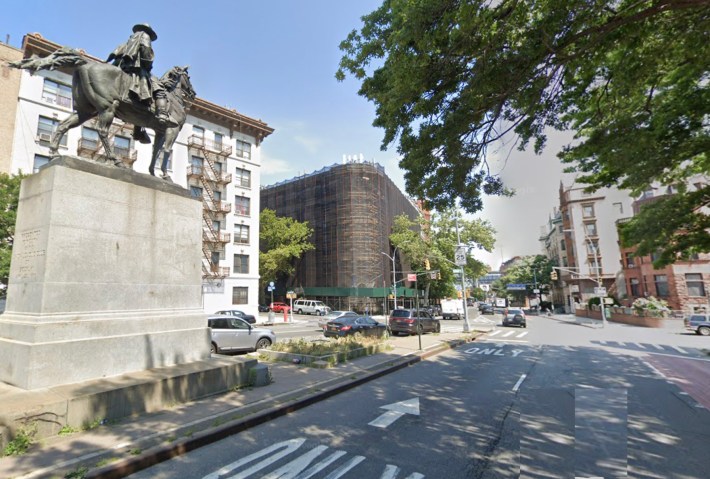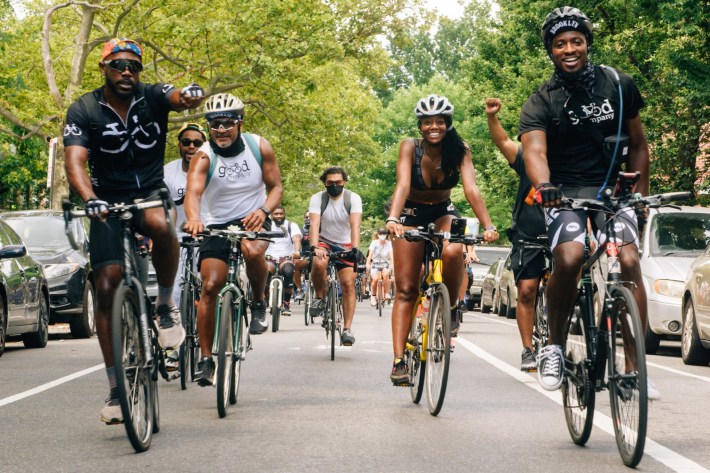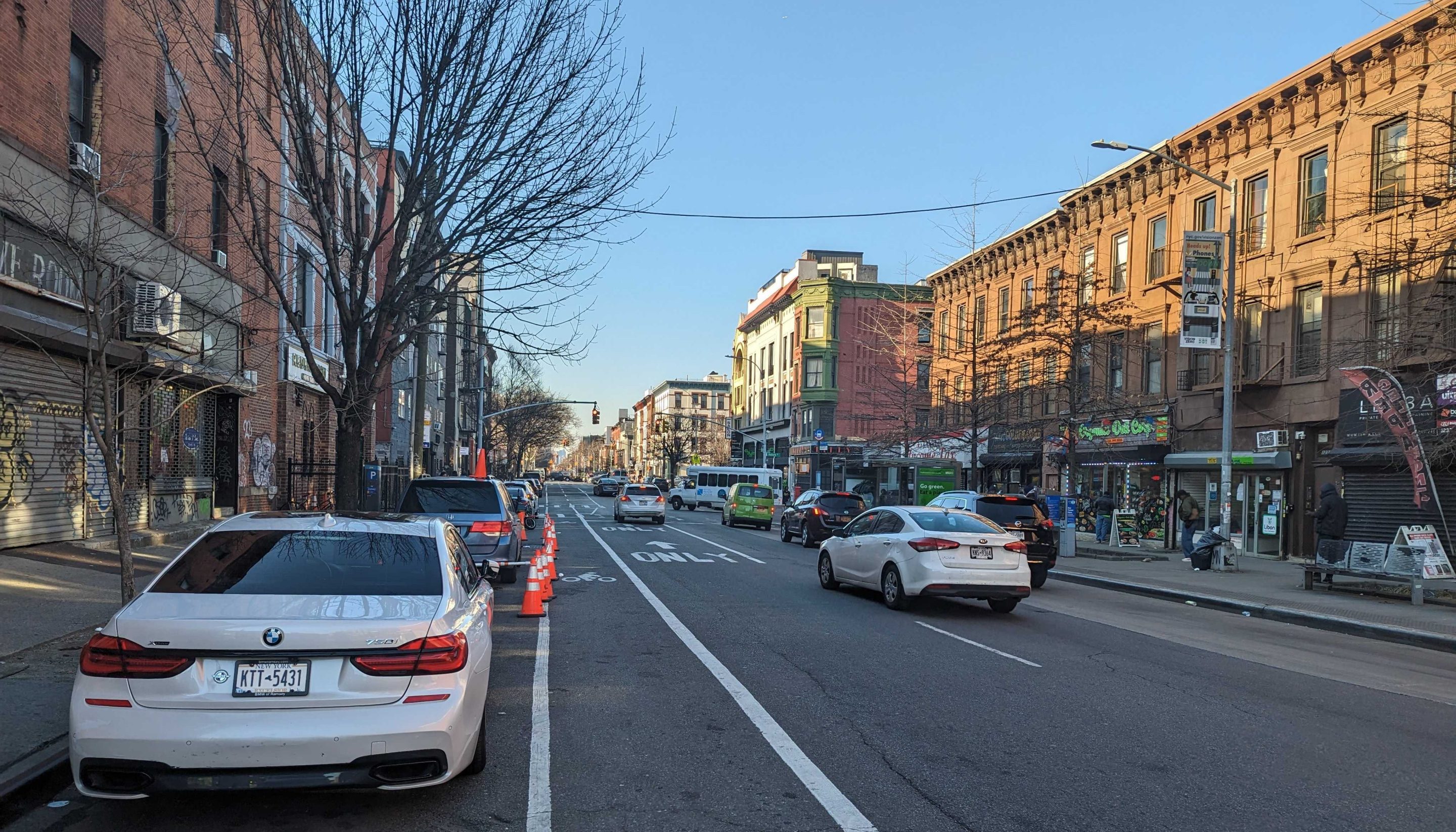They want a better Bedford Avenue.
The Department of Transportation must add a protected bike lane on the dangerous stretch of Bedford Avenue between Flushing and Flatbush avenues, a major north-south spine that spans multiple neighborhoods in Brooklyn, a group of advocates led by a Black-run bike club is demanding.
Despite painted bike lanes between the roadway's southern terminus at Emmons Avenue in Sheepshead Bay and Flushing Avenue in Williamsburg, advocates are reminding the DOT that paint is not protection.
"Bedford Avenue is the longest street in Brooklyn, it's a popular street to bike on, but it's also not the safest street, either," said Drew Bennett, the founder and executive director of Good Co, the Black-led bike club that is spearheading a petition drive with Transportation Alternatives. "So getting a protected lane would allow people to get from Point A to Point B a lot more safely."
The mostly two-way Bedford Avenue has multiple configurations on its 10-mile run through Brooklyn. Heading north from Emmons Avenue to Dean Street in Crown Heights, Bedford has just one motor lane and a painted bike lane in each direction. But at Dean Street, where Bedford and Rogers avenues merge at the famed statue of Ulysses Grant, the roadway becomes a northbound war zone befitting the beloved Union general: three jammed lanes for cars and trucks, plus a bus lane, but no bike lane at all.

The painted lane returns north of Atlantic Avenue and remains until Flushing Avenue at the southern end of the Hasidic portion of Williamsburg. The bike lane never returns.
There used to be one, but in 2009, then-Mayor Mike Bloomberg erased 14 blocks of a bike lane on Bedford Avenue between Flushing Avenue and Division Street, allegedly after members of the neighborhood's Hasidic community complained about the scourge of scantily clad hipster cyclists. Guerrilla activists then redrew the bike lane but the city removed that as well — and it never was repainted. (Rabbi David Niederman, the president and executive director of the United Jewish Organizations of Williamsburg and North Brooklyn declined to comment for this story.)
Beyond religious concerns, the politics of redesigning this stretch of Bedford between Flatbush and Flushing avenues may prove challenging, given that the street cuts through multiple neighborhoods (Bed-Stuy, Crown Heights, Prospect-Lefferts Gardens and East Flatbush) governed by five City Council members and five community boards. In the past two decades, the Department of Transportation has not pitched many bike lanes, protected or otherwise, to those community boards, though some painted bike lane projects like the Empire Boulevard bike lane and the Classon Avenue bike lane have been completed.

The DOT also installed a protected bike lane on Buffalo Avenue in 2022 and protected bike lanes surrounding Prospect Park, on Flatbush Avenue in 2020 and Parkside Avenue in 2021. But other proposals have gone down in flames, including a painted bike lane on the section of Franklin Avenue south of Eastern Parkway, and the stalled effort to bring a painted bike lane network to Flatbush, Midwood and Kensington and another in East Flatbush. When the DOT came to Community Board 17 with a proposed neighborhood network of painted bike lanes in East Flatbush, Assembly Member Rodneyse Bichotte Hermelyn suggested bike lanes worked for the much whiter Brooklyn CB 2 but not the 78 percent Black CB 17.
Community Boards 3, 4 and 9 are also plurality or majority Black neighborhoods, which is why Bennett said it was important for Black cyclists to be part of the organizing around the project.
"One of our slogans is, 'We bike, too,' and Good Co. is primarily comprised of Black and brown cyclists from all over New York. I've lived in Brooklyn my entire life, my whole board is from Brooklyn, from Brownsville and Canarsie and we've been biking our entire lives. So for people to say our community aren't the bikers, it's about how they don't necessarily feel represented in those spaces," said Bennett.
A protected lane between Flatbush and Flushing avenues is crucial because it would add safe north-south bike route to central Brooklyn on a street that has long stood out for its less-than-ideal safety. It's not hard to find photos of the chronically blocked bike lane north or south of Atlantic Avenue or even the carnage that comes from mixing cyclists with vehicles traveling at high speeds. In at least one instance the painted bike lane was the perfect place for a group of men to run a scam involving hitting a cyclist with their car.
Incredible story on Nextdoor about a guy who was hit by a car on Bedford Ave, was assaulted and yah, the cops didn’t do shit. Maybe one day @nyc_dot will fix Bedford. Until then…. #VisionZero #BikeNYC pic.twitter.com/yPuT53YlBV
— JarekFA (@JarekFA) June 3, 2022
The city's own data and independent crash-tracking efforts also show Bedford could use some road calming efforts. Bedford Avenue between Flatbush and Manhattan avenues was previously listed as a Priority Corridor, which means it was among the worst 50 percent of a borough's roadways for pedestrian fatalities or injuries. But it was dropped as such a corridor in the agency's Pedestrian Safety Action Plan after its "killed or seriously injured" rate per mile dropped from 7.6 to 4.5 between 2016 and 2021. Part of that drop, however, was the result of DOT extended the "corridor" fully to Emmons Avenue, which gave all of Bedford a KSI per mile of 3.2, lower than the most dangerous 50 percent of roadways.
But the document also showed that Bedford Avenue is still in a priority area, which the DOT defines as the most dangerous locations based on the number of pedestrian deaths or severe injuries. Bedford Avenue also runs through what the DOT calls Tier 1 and Tier 2 Priority Investment Areas, locations the DOT says are areas with high population densities and under-served neighborhoods that have not gotten their share of street safety improvements, in the Streets Master Plan.
That missing investment is seen in the City Council districts that Bedford Avenue runs through. Crown Heights and Prospect-Lefferts Gardens rank near the bottom of the Council's 51 districts for percentage of street miles with protected bike lanes according to a Spatial Equity Tracker created by Transportation Alternatives and MIT. Meanwhile, Bedford-Stuyvesant and East Flatbush have no protected bike lane miles at all.
With or without an official status as a priority corridor, people are still getting hurt on Bedford. Between 2020 and 2022, there were 1,168 reported crashes on just the four-mile run between Flatbush and Flushing avenues, causing five pedestrian deaths, and injuries to 157 cyclists, 92 pedestrians and 452 motorists.
There are so many cyclist injuries on the stretch with a painted lane because drivers often simply treat it as a parking lane, uses say.
"The heavily used existing painted bike lane on Bedford Avenue puts people on bikes at risk because it is chronically blocked by double-parked vehicles, forcing riders to merge with speeding vehicles," said Transportation Alternatives Brooklyn organizer Kathy Park-Price. "We need a safer, better Bedford Avenue now." (Bennett, a Prospect-Lefferts Gardens resident, said he bikes on Bedford Avenue about once or twice per week, but generally chooses routes that are safer.)
To demonstrate the need for the bike lane and who might use it, Park-Price said that Good Co. and Transportation Alternatives are hosting a ride on Bedford from Flatbush to Flushing on Earth Day, which is April 22.
Every community board along the route is also a community district where the majority of homes have no vehicles available to them, according to the census, including 63.6 percent of homes in CB 3 and 70 percent of homes in CB 8.
And despite the hostility some community boards along the route have shown towards bike lanes, some elected officials on Bedford Avenue have thrown their support behind this project or other cycling-friendly causes. Council Member Chi Ossé, who represents Bedford-Stuyvesant campaigned on getting a protected bike lane on Bedford Avenue, and supports the petition effort.
"Bedford Avenue is a critical Brooklyn artery," said Ossé. "For cyclists, it is also dangerous and even deadly. A protected bike lane here would make our streets safer, our air cleaner, and our traffic more manageable. It should be built as soon as possible."
And another Council member who represents part of Bedford Avenue said the project is long overdue.
"Bedford Avenue needs a protected bike lane that will make our community safer," said Council Member Lincoln Restler (D-Williamsburg). "We have been discussing a protected bike lane on Bedford for many months with DOT, and I strongly support this project that will help us achieve a truly protected network of bicycle lanes across Brooklyn." (His predecessor, Steve Levin, failed to garner support from Niederman and his group.)
The DOT did not say much about the petition beyond possible future talks about better bike infrastructure on the street.
"We appreciate the support and look forward to future discussions with the community about enhancing cycling infrastructure," said DOT spokesman Vin Barone.






